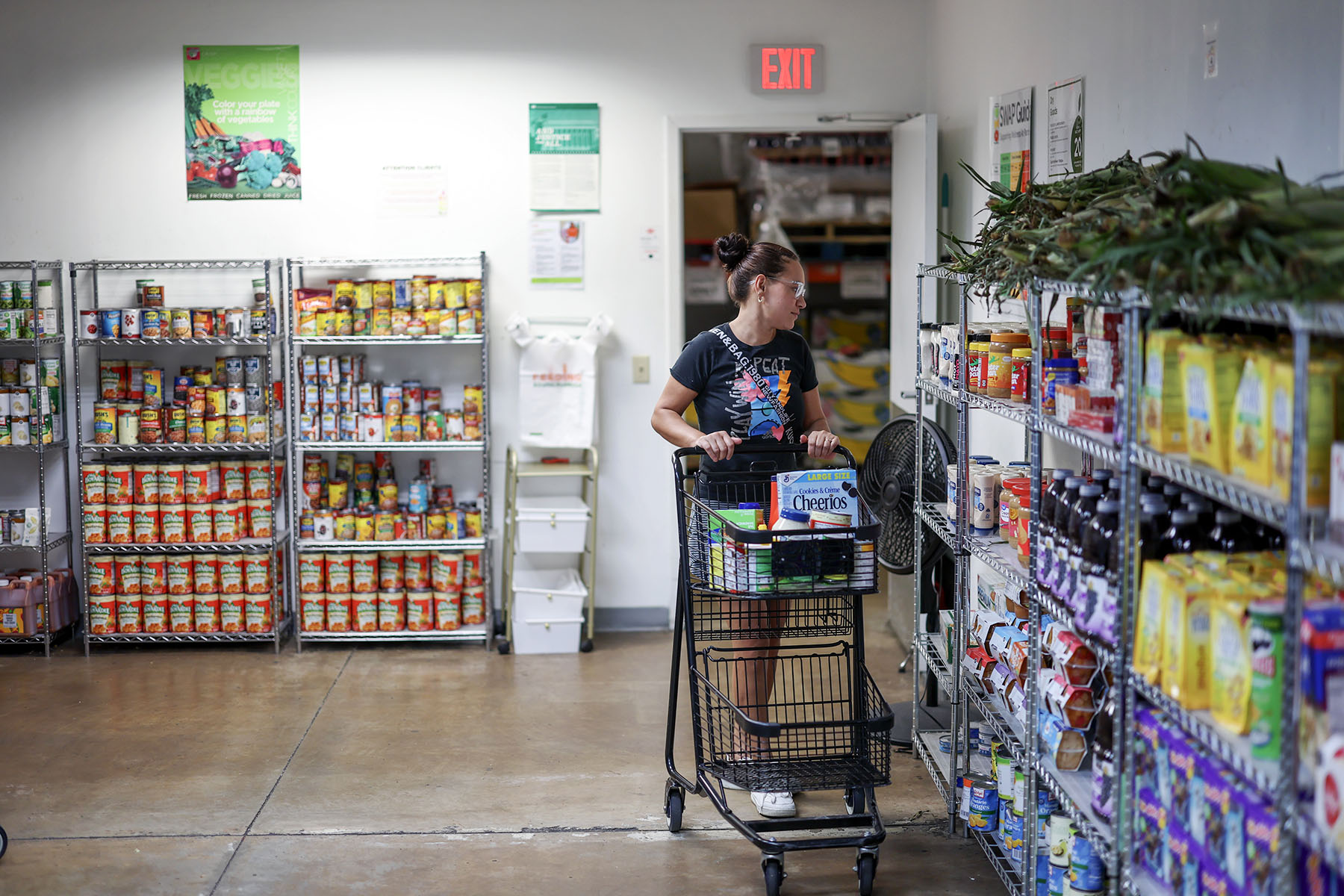Food banks in several states, including Idaho and Maine, are bracing for an influx of visitors. In South Carolina, a state emergency relief fund will be tapped to respond to demand. And in North Dakota, the state’s sole food bank has started an emergency fundraising campaign.
As lawmakers in Congress extend a nearly record-breaking federal government shutdown into possibly another month, massive cuts to critical aid are looming for the nation’s most vulnerable people — including women, postpartum parents and children.
The Supplemental Nutrition Assistance Program, known as food stamps or SNAP, is set to run out of money beginning Saturday, the start of November. Separately, the Special Supplemental Nutrition Program for Women, Infants, and Children, known as WIC, has no long-term funding for November. (The White House tapped some contingency funding for WIC in October, but advocates warn it’s set to run out over the next few weeks.)
SNAP, which has been around for 60 years, ensures nearly 42 million low-income Americans, including nearly 16 million kids, can access money to buy groceries. The funding is typically issued through debit-style cards that are not scheduled to be refilled on November 1 (or throughout the month since some states administer the program on a staggered calendar.)
“The fact that we’re talking about so much money and so many families that depend on it — not having the benefits go out next month is really going to be a crisis,” said Marlene Schwartz, director of the Rudd Center for Food Policy & Health at the University of Connecticut.
WIC, developed in the early 1970s, provides some money for food purchases, but it primarily offers resources aimed at making sure low-income new parents can raise healthy babies. That includes prenatal care, nutrition education and breastfeeding support. The program is a lifeline, serving 7 million people, including nearly half of all babies born in the United States.
Cutoffs to one or both programs would be unprecedented — Congress has never let funding for these vulnerable populations lapse, even during previous shutdowns. The ripple effect could be hungry families and pregnant and postpartum parents with fewer resources — including formula in some cases — to keep their babies healthy.
Food banks — the charitable aid system that distributes food to pantries and meal programs around the country and is funded through a range of sources, including private donations — are offering help as panic begins to set in among families. Many existing recipients of food pantries don’t qualify for SNAP because their income threshold, while potentially low, might not be low enough. It means strained resources for more people.
“Food banks and food pantries are going to step in during this period as a little bit of a bridge,” said Eric Hodel, chief executive officer for the Midwest Food Bank, which distributes food that reaches nonprofits in 25 states and runs distribution sites in two international facilities. “At times, we’ve maybe bridged some people for a day or for a week. If we have extended delays in the administration of SNAP, I think at the food bank we’re preparing that we may have to bridge that a little bit longer and further — so we’re continuing to do what we do to the best of our ability.”
But it’s not expected to be enough. Feeding America, the organization that provides a nationwide network of food banks, estimates that food pantries provide about one meal to every nine provided by SNAP.
“The most challenging and heartbreaking situation for staff members and volunteers is when the pantry shelves are empty, and they must turn people away — veterans, seniors, families with young children. Yet, with increasing demand and the high cost of food, this is already the harsh reality for so many and, without immediate action, will become a reality for countless more people across the country,” said Claire Babineaux-Fontenot, CEO of Feeding America, in a statement.
It’s a dynamic playing out amid rising grocery prices. Schwartz added: “The charitable food system is there to support families, but it is tiny compared to the amount of money that is available through SNAP.”
That would be particularly relevant for the separate WIC program, explained Nell Menefee-Libey, senior public policy manager at the National WIC Association, which advocates for WIC staff who are based around the country. WIC is the nation’s largest breastfeeding support promotion program — a resource that cannot be filled by the charitable food system. The program also provides tailored foods that meet the specific nutritional needs of pregnant and postpartum parents, as well as those of children from infancy through their fifth birthday. It would also be at the whims of potentially inconsistent food offerings at food pantries.
And if a family is using infant formula, that can be the sole source of nutrition for a young child. For the most part, food banks have not historically supplied infant formula, said Menefee-Libey.
“It’s a pretty delicate supply chain, so trying to figure out what it would look like to get additional infant formula to food banks to support families in the event of a widespread disruption to WIC is incredibly challenging,” she said.
Advocates for SNAP benefits note that the U.S. Department of Agriculture (USDA), which administers WIC and SNAP, has contingency funds — between $5 billion and $6 billion, according to some estimates, for SNAP alone. The agency claims it’s unable to use those funds for the program. Nearly 60 percent of SNAP beneficiaries are children and older adults.
“Bottom line, the well has run dry,” reads part of a message on the USDA website.
Bottom line, the well has run dry.”
U.S. Department of Agriculture
The assertion is being challenged in court. On Tuesday, a coalition of 25 Democratic-led states and the District of Columbia filed a lawsuit against the Trump administration over its plans to cut SNAP access.
“The funds are available to continue SNAP right now without any interruption,” said Democratic Sen. Peter Welch of Vermont during a news conference this week. “So that is a decision the president is making on his own — on his own — to allow people to go hungry.”
While lawmakers in Washington remain deadlocked over how to reopen the government, some are also discussing stand-alone legislation that could continue to fund food assistance. The idea has bipartisan support, but whether there’s enough political will to do something within days is unclear for now.
USDA tapped $150 million in contingency funds for WIC in October, and then a separate $300 million transfer from tariff funds. Menefee-Libey said if there is no clarity soon, the consequences will include WIC staff being furloughed, which would impact how families are able to access resources.
“I think we’re really fortunate that this is a program with broad bipartisan support, that the White House and USDA have both stepped in to provide quite a bit of support for the program during the shutdown,” she said. “But even all of the extraordinary measures that have been taken only get us through October. It is entirely fair to say that there needs to be a certain amount of urgency to make sure that we don’t see folks losing access to WIC benefits as soon as November.”
Carolyn Vega is associate director of policy analysis at Share Our Strength, a nonprofit that seeks to address hunger and poverty and oversees a No Kid Hungry campaign that is focused on ending child hunger.
Vega worries about the different groups who are most likely to suffer, including single-parent households and children who may show up to school hungry. (There are federal food assistance programs offered at schools, including for breakfast and lunch, which are not expected to be impacted by the shutdown.)
“The fastest and best way to address the looming hunger cliff is for USDA to step in and provide the benefits that families are eligible for and are counting on,” Vega said.
This cliff comes as the Trump administration announced in September that it would stop tracking food insecurity in American households through an annual report, claiming through a news release that the work was redundant, costly and politicized. Schwartz criticized the move, and its broader implications amid the shutdown.
“That measure has been around for as long as I can remember, and I’ve been in the field for a pretty long time,” she said. “The fact that they’ve just decided not to measure it — it’s like they’re trying to make it harder to really document the harm that’s occurring.”







